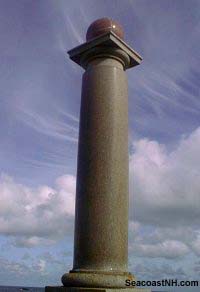|
FRESH STUFF DAILY |
|
|
||
|
|
||
|
|
||
|
SEE ALL SIGNED BOOKS by J. Dennis Robinson click here |
||
Page 3 of 3
So that's where Pepperrell eventually attacked, dragging cannon over swampy areas thought impossible to navigate. The siege itself lasted 45 days, from the end of May until the 7th of July. A steady rain of shot battered the walls and terrorized civilians. French accounts offer horrible details of suffering townspeople. One report tells of a baby, blown to pieces while sitting in his father's lap. The father was untouched, but the cannon ball passed through a wall, killing two more children. Soldiers on both sides of the battle were often so close they could taunt eachother over the collapsing walls. Yankees offered the starving French some of King George’s bread and asked if there were any good-looking girls in side. "Come in and see for yourself!" the French called back. Just 100 New Englanders died in battle, 60 of those in an abortive night raid to storm the badly damaged Dauphin's Gate. At the first attempt, the moon was too bright. At the second, the officers in charge did not show. At the third, the men were too drunk to row. In the fourth, a noisy New Englander alerted French sentries who killed or captured most in the raiding party. In the end, the greater luck was with New England. After Warren captured a critically important French supply ship and Pepperrell got his cannons to the high ground, the handwriting was on the fortress wall. The French surrendered to the British king. But it was the end of luck for the men of New England. The farmer boys and fishermen who won the day were then required to hold the fortress until the British regulars arrived. They did not arrive until the following Spring of 1746. Through the winter as many as 17 men died per day, a total of 800 Yankees dead and over 1,000 ill from cold and disease. Too tired and weak even to dig graves, New Englanders dropped the corpses of comrades beneath the floorboards of abandoned French homes.
Almost bankrupted by the costly raid, New Englanders finally collected the debts of war from Britain. Sir William Pepperrell eventually got Shirley’s old job and was appointed royal governor of Massachusetts. When, a few years later, the British again battled France and retook Louisbourg and razed it to the ground, he was appointed Lieutenant General, but died in 1759 and was buried in Kittery. Following the second siege, the ruins of Louisbourg lay almost forgotten until a small museum was dedicated on the distant Cape Breton site in the early 20th century. An obelisk, raised near a rocky beach by Americans in 1895, is the only memorial to the Yankee dead. And that would be the whole story, a footnote in the high school history texts of four nations. Then in the 1960s the Canadian government authorized a bold $25 million restoration project, the largest ever seen in North America at the time. Fortress Louisbourg has been rebuilt, timber by timber, stone by stone. Today one-fifth of the entire city stands on its original foundations, scrupulously renovated from millions of documents found in French archives. Today Cape Breton re-enactors, men, women and children, walk purposefully through the streets of the fortress – feeding animals, baking bread, serving meals, guarding the gates. It is, for them, 1744 – the fateful year before the men from New England will arrive. Visiting Louisbourg is as close to the real thing as imagination gets – far more authentic than anything a Hollywood film or theme park can deliver. Among the souvenirs taken from the first siege, according to historian Joe Frost, was the bell from a Louisbourg church. One of Pepperrell’s men donated the bell to the Queen’s Chapel, what is today St. John's Episcopal Church in Portsmouth. When St. John's burned in 1806, the Louisbourg bell was sent to Paul Revere in Boston for repair. Today the name Paul Revere still rings a bell with all Americans, while the bell from the Seige of Louisbourg jogs few memories in Portsmouth. Even the great Pepperrell legacy remains as foggy as the view from a Nova Scotian bay.
Copyright © 2006 by J. Dennis Robinson. All rights reserved. Dennis Robinson is editor and owner of the Seacoast web site SeacoastNH.com.
Please visit these SeacoastNH.com ad partners.
News about Portsmouth from Fosters.com |
| Monday, April 29, 2024 |


|
Copyright ® 1996-2020 SeacoastNH.com. All rights reserved. Privacy Statement
Site maintained by ad-cetera graphics

 HISTORY
HISTORY



 Three years after the battle of Louisbourg, in a political maneuver, the British gave the fortress back to the French. This greatly angered the residents of New England, already ired by the needless loss of Yankee life following the siege. The men of New England, tested at Louisbourg, felt a growing territorial pride and a sense of American, not British, nationalism. With little more than willpower, New England had defeated a supposedly invincible foe. Evolving from a raucous gang of privateers, the colonies had worked together, been tested, and emerged more united.
Three years after the battle of Louisbourg, in a political maneuver, the British gave the fortress back to the French. This greatly angered the residents of New England, already ired by the needless loss of Yankee life following the siege. The men of New England, tested at Louisbourg, felt a growing territorial pride and a sense of American, not British, nationalism. With little more than willpower, New England had defeated a supposedly invincible foe. Evolving from a raucous gang of privateers, the colonies had worked together, been tested, and emerged more united. 














